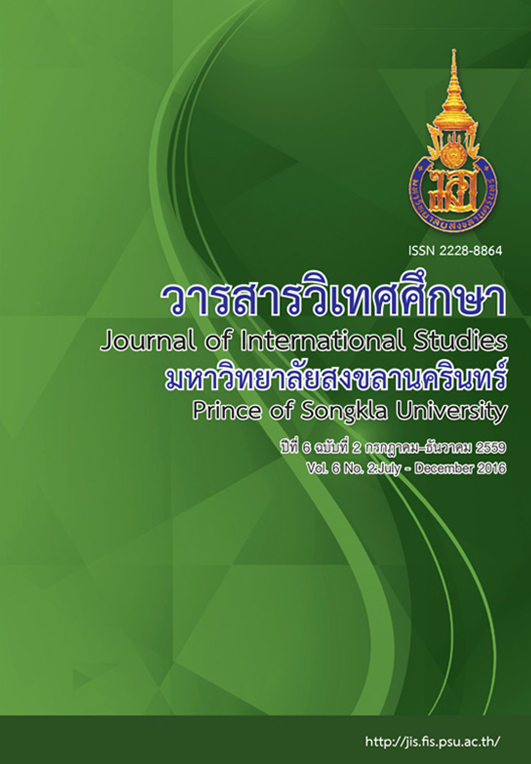Western Settlers’ Impact on Phuket’s Demographic Diversity in an Era of International Tourism
Main Article Content
Abstract
This study aims to explore western settlers’ impact on the demographic diversity of Phuket and to analyze socio-cultural changes and consequences of increase in cultural diversity caused by western settlers in an era of international tourism.
A large number of western settlers residing on the island of Phuket produce significant social changes in Phuket society in the era of international tourism by generating a greater diversity in the demographic composition of Phuket. Western settlers appear in various guises, such as retirees, investors, business people, diplomats, short-term-staying young westerners, and Westerners who are married to Thai spouses. Their settlement forms a new generation of luk krueng farang, who are children of mixed ethnic Thai and farang parentage. The dominance of Thai-Chinese luk krueng born during the mining era changing into that of luk krueng farang, which group is rising in numbers in the international tourism period. Western settlers have become a key component of Phuket’s demographics. Those already show a high level of cultural diversity, which is visibly reflected through many religious and cultural sites: Buddhist temples, Sikh and rnational tourism.
Article Details
Statements and opinions expressed in articles herein are those of the authors and do not necessarily reflect the position of the editors or publisher.
Article, information, text, image, etc. which are published in Journal of International Studies, belong to Journal of International Studies. If anybody or any organization would like to use part or whole of them, they must receive written permission from Journal of International Studies before usage.
References
Apsorn Na Ranong. (2007). Economic Changes from Tin Mining to Tourist Industry in Phuket 1941 – 1987. (Master of Arts), Silpakorn University, Bangkok.
British International School, Phuket. (2014). Number of Students, March 2014. Phuket.
Dhiravat Na Pombejra. (2002). ‘Towards a History of 17th Century Phuket’, in Sunait Chutintaranond and Chris Baker (eds), Recalling Local Pasts: Autonomous History in Southeast Asia. Bangkok: Silkworm Books, pp. 89-126.
Gilroy, P. (1993). The Black Atlantic: Modernity and Double Consciousness. Cambridge, MA: Harward University Press.
Henderson, J. C. (2007). Corporate Social Responsibility and Tourism: Hotel Companies in Phuket, Thailand, after the Indian Ocean Tsunami. International Journal of Hospitality Management, 26(1), 228-239.
Hodges K. (2015). Pricing Phuket Plots: The attractive north (March 23, 2015). Retrieved on May 1, 2016 from: http://www.phuketgazette.net/phuket-property/Pricing-Phuket-Plots-attractive-north/53648#ad-image-0
Interview. Jesada Soiport. May 10, 2016.
Iyall Smith, K. E. (2008). Hybrid Identities: Theoretical examinations. In Iyall Smith, K. E. & Leavy, P. (Eds.) Hybrid Identities: Theoretical and empirical examinations (pp.3-11). Chicago: Haymarket Books.
Kreag, G. (2001). The impacts of tourism. Minnesota Sea Grant. Retrieved June 2, 2015, from http://www.seagrant.umn.edu/tourism/pdfs/ImpactsTourism.pdf.
Mackay, C. R. (2013). A History of Phuket and the Surrounding Region. Bangkok. White Lotus Press.
Marzuki, A. (2012). Local residents’ perceptions towards economic impacts of tourism development in Phuket. Tourism Original Scientific Paper, 60(2). Pp 199-212.
Nicha Tovankasame. (2010). The Syntax and Lexicon of Thai Pidgin English in Phuket. (Master’s Thesis, Program in English as an International Language, Graduate School, Chulalongkorn University).
Phairat Suthakorn. (1992). The Distribution of Tin and Associated Minerals in Thailand, in Proc. of the National conference on “Geologic resources of Thailand: Potential for future development”, 17-24 November 1992, Bangkok, Thailand, Depart of Mineral Resources, pp. 450-486.
Phuket Immigration Office. (2013). Information on various nationalities of business operators applying for Business Visa in Phuket. Phuket: Author.
Phuket Immigration Office. (2013). Information on top 10 nationalities applying for Marriage (to a Thai woman) Visa. Phuket: Author.
Phuket Immigration Office. (2015). Information on international retirees in Phuket. Phuket: Author
Phuket Provincial Employment Office. (2013). Information on immigrant workers in Phuket. Phuket: Author.
Phuket Provincial Employment Office. (2015). Information on international expatriates with work permits holding in Phuket. Phuket: Author.
Phuwadol Songprasert. (1992). Singaporean Capital: Monopoly of the Thai Rubber and Tin Markets. Bangkok: Chulalongkorn University Printing House.
Preeyachanan Saisakares. (2004). The Influences on the Architecture of Phuket Old Town. (Master of Architecture), Chulalongkorn University, Bangkok.
Royal Norwegian Consulate, Phuket. (2015). Honorary/General Consulates in Phuket. Phuket: Author.
Schatz, J. (2014). Phuket Business: Comprehensive worldwide survey examines the expat experience. Phuket Gazette, (November 25, 2014). Retrieved on March 05, 2015 from http://www.phuketgazette.net/phuket-business/Comprehensive-worldwide-survey-examines-expat-experience/39572
Suliman Narumon Wongsuphap. (2001). Sai yai trakun “Nganthawi” lae withi lae phalang mangkon tai (สายใยตระกูล “งานทวี” แลวิถี และพลังมังกรใต้). Bangkok. The Thailand Research Fund.
Suree Liangsangtong. (1981). An Analytical Study of Phuket’s Economy during 1853 - 1932. Master’s Thesis, Department of History, Graduate School, Chulalongkorn University.
Uthoff, D. (1997) Out of the tin crisis into the tourism boom: The transformation of the tropical island of Phuket by international tourism. Applied Geography and Development 49: 7-31.
Vertovec, S. (1999). “Conceiving and Researching Transnationalism.” Journal of Ethnic and Racial Studies Vol. 22:447-462.
Wardhaugh, R. (2010). An Introduction to Sociolinguistics. Singapore: Wiley-Blackwell.
Warren, W. (2009). Phuket: Pearl of the Orient: Pearl of the Orient. Tuttle Publishing.


